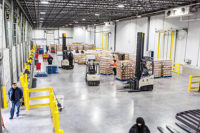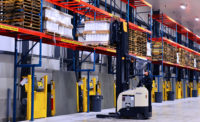When it comes to cold storage building materials, there is no one size fits all. Regulatory changes, sustainability features and standing up to Mother Nature are key factors in selecting the right door, wall and panel for any cold storage facility. Here’s a rundown of newly developed cold storage building materials and how they’re designed to help the cold food industry meet today’s ever-changing challenges and trends.
Walls for all
Randall Manufacturing, Elmhurst, Ill., created GREEN InsulWall, an insulated curtain wall that meets ASTM E-84 Fire Resistance Standards. Made from recycled insulation, GREEN InsulWall provides commercial buildings with a state-of-the-art, energy-conserving, modular wall system. This heavy-duty 18-ounce vinyl curtain wall can also be moved, re-hung and re-used as business needs change. Additionally, InsulWall’s modularity and ease of installation allow it to be used in hard-to-maneuver areas such as the dock and between racking.
“The regulatory environment has drawn more attention to proper temperature control throughout the cold chain. Whether food is in transit, in storage or at point of sale, food integrity and proper climate control is paramount,” says Kristine Grudis, warehouse division manager. “InsulWall has met the unique needs in the food industry with its ability to create temperature- and humidity-controlled areas quickly, cost effectively and with its modular design.”
A recent InsulWall application with Port Jersey Logistics, Cranbury, N.J., for example, created a heated room for olive oil while achieving a 1-year ROI based on energy savings. For Driscoll Berries, Watsonville, Calif., InsulWall maximized floor space by creating a seasonal temperature-controlled distribution area within the unused space.
“We are seeing more and more food distributors utilizing 3PLs for storage purposes,” Grudis adds. “This has increased the need for a temperature-controlled warehouse space. The warehouses require material that is modular and flexible, so 3PLs can quickly regroup and reconfigure space as client needs change.”
Doors and more
Milwaukee-based Rite-Hite Doors developed LiteSpeed Clean, a roll-up door that operates up to 65 inches per second. Compliant with cGMP, FDA and USDA standards, this door features tapered surfaces, minimizing dust collection points.
Rite-Hite also introduced a 1-piece radial header that’s machined from a solid block of UHMW plastic.
“We’re striving to reduce surface-to-surface contact areas with our doors to meet regulations that might come in the future,” says Jon Schumacher, director of marketing. “Some lines of our industrial curtain walls were originally developed with food applications in mind, so they have met the most stringent food safety regulations from the beginning.”
Other building materials include the FasTrax FR cold storage door, which combines Rite-Hite’s unique thermal air system, and the R-4 InsulMax insulated curtain, which minimizes the potential for frost buildup.
Rite-Hite’s SCW curtain walls by Zoneworks create safe and effective antimicrobial washdown environments that keep in line with HACCP best practices by reducing the potential for cross contamination during routine production processes.
“High-speed doors are much more energy efficient in high-traffic areas,” Schumacher adds. “Bigger, slower doors might have great R-values, but if they’re left open for long periods of time due to slow cycle times, there’s really no benefit. They can also lead to headaches if there’s an accident with a forklift that compromises the seal of the door. Rite-Hite developed a door that can operate at up to 100 inches per second, saving precious time that temperature-controlled areas can be infiltrated. If this door is impacted by a forklift, it can automatically re-feed itself back on the door track, so the operation doesn’t miss a beat.”
Panels that push the limits
When the Canadian Food Inspection Agency (CFIA) banned the use of field-applied applications of fiberglass reinforced plastic (FRP) due to the inconsistent adhesion and voids behind the sheets, Kingspan Insulated Panels, Deland, Fla., addressed this issue by developing a fully factory adhered FRP sheet to an insulated metal panel, while still meeting the new CFIA and USDA requirements for applied finishes in a controlled environment. The newly designed KS45FRP partition panel for food processing and washdown environments is ideally suited for thermally controlled environments such as cold food processing and packing facilities. Available in a full 45-inch width and cut to length for full or partial height, the KS45FRP panel enables customers to use on interior surfaces and expose to higher cleaning concentrations, heat and humidity common in washdown environments.
“Cold storage facilities can be some of the highest energy consumers,” says Steve Mauro, national sales director, cold storage. “Refrigeration loads and efficiency require that the building envelope perform at the highest level. Insulated metal panels provide precise thermal control and the highest R-values in the industry, enabling building owners to benefit from other efficiencies in lighting and building controls.”
Unique building solutions
ClearSpan Fabric Structures, South Windsor, Conn., added a new structure, The Hybrid Building, to its HD building solutions.
Hybrid Buildings offers the option of steel or fabric side walls with the durability of Hercules Truss Arch Buildings. Since there are no internal support posts, the building allows for maximum usable space. Plus, the fabric cover comes in several colors, and the polyethylene cover allows the transmission of abundant natural light.
“We have recently introduced hybrid buildings with the options of steel covers/sidewalls, giant bi-fold doors and structural insulated panel (SIP) structures to provide insulation,” says Geoffrey Ching, sales manager.
From doors to walls to insulated panels, today’s cold storage building materials provide sustainable options for nearly every cold storage environment.
For more on these and other cold storage building materials, go here.







